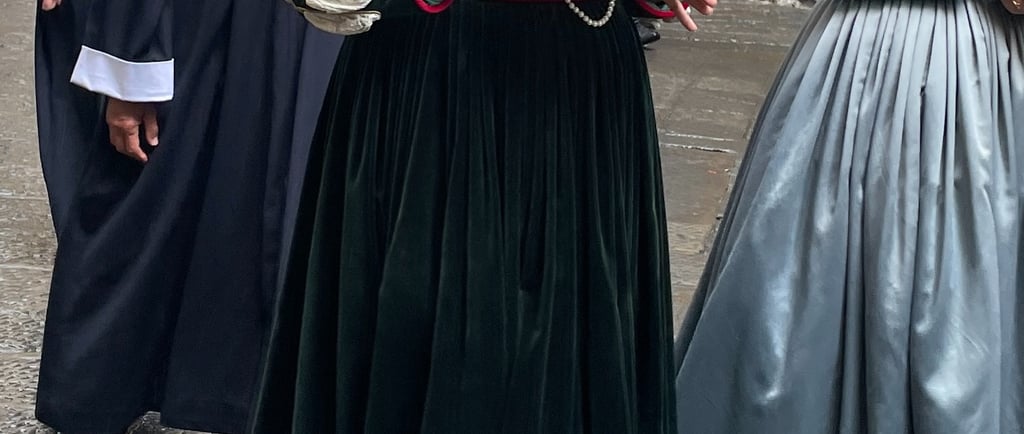Fashion in the Thirteenth Century
What they wore in Guidaloste's Fiorenza
ITALIAN RESEARCH
7/15/20243 min read


Florence often has historical processions or fayres that make it easy to imagine how people dressed in the past. However, for the most part, these costumes are from a later medieval/ renaissance period, around the fifteenth and sixteenth centuries, when the power of the Medici family was at its height. During the thirteenth century when The Power of the Wouive is set, dress for both men and women was a simpler fashion that was also fairly uniform across Europe. Men wore a knee length wool tunic (or velvet or silk for the rich) over a linen undershirt, and hose – leggings or tights – which were probably two piece and attached to belt rather than the two-legged single garment we recognise today. Women wore simple, full length dresses and with a wimple and veil on the head (white silk or brocade for rich and natural linen or cotton for poor) although in Italy, women wore their head uncovered more than in rest of Europe. Both men and women might wear a surcoat which was a type of sleeveless garment, often without side seams, worn over the tunic.
Brightly coloured clothes were popular, as dyeing cloth was expensive, so more colourful attire was seen as a status symbol. All cloth was dyed using natural ingredients. These could be easier or harder to obtain, depending on the source. Red, for example, was made from madder root which was only harvested once a year. This made it more expensive than woad blue, since woad leaves could be collected several times a year. Madder red was a burnt, brownish red. Woad blue was a deep indigo. The red could sometimes be mixed with sappanwood to produce a richer cherry or mulberry shade, depending on the fixing agent used. A bright scarlet or crimson colour could be mixed by adding kermes - an insect found in the kermes oak. Similarly, carmine red could be produced from the cochineal beetle. Obviously these were very expensive as a great number of insects would be required to produce a relatively small quantity of dye. Lapis blue could be made from powdered lapis lazuli crystal, which was distinguishable from the more affordable woad by its bright, electric colour. Italy was a highly profitable trading nation so its merchants also had huge access to foreign dyes which they could sell at inflated prices. These brighter colours were, therefore, the preferred choice of the nobility and well-off merchants as they were a clear indication of wealth and prosperity.
Peasants tended to make do with natural, undyed grey and cream wool or linen, or a more limited, muted colour palette of yellows, greens and browns. Yellow was made from local plants such as weld, dyers broom, heather or Persian (buckthorn) berries. This could then be mixed with woad blue to make green. Brown was readily available from walnut shells and bark. Several cloths could go through the same dye bath, meaning that the first cloths dyed would be rich vibrant colours, and thus more expensive, but by the time several cloths had been dipped, the colours would be significantly more faded which reduced their value and made them more affordable to lower classes of society. Pink, being the result of faded madder red, was affordable for all, and poorer people could wear woad but the intensity of the colour would reflect their wealth or lack thereof. A violet colour (orchil) could be produced from lichen but this was not a long-lasting dye and would fade rapidly in the sunlight or after a few washes.
Another way folk could express their wealth was through their accessories. Peasants tended to wear few accessories since their clothing needed to be comfortable and practical for working in. They might wear a belt to pull their loose fitting tunic in at the waist, and women might wear an apron over their dress to keep it clean as sometimes they may only have the one dress and an apron would be considerably easier to clean that the whole dress. The rich, however, would show their wealth with brooches, rings and belts embedded with beads and precious gems. Their clothes were often tailored, with embroidery sewn onto the garments, and brocade, or fur trim such as ermine. On their feet, the poor would have basic laced boots made from undyed leather, while the rich wore shoes made from leather, silk or velvet, again often embroidered or embellished with buckles, beading or jewels At the end of the thirteenth century you might see more pointed shoes which were beginning to come into fashion. Men, particularly soldiers or those who rode a lot, would wear boots.
As the thirteenth century drew to a close and the fourteenth century began, sumptuary laws began coming into play as women's necklines started to plunge and men's hemlines became ever shorter! For the most part, however, despite clothing being an obvious display of wealth, dress in the late 1270s and early 1280s, when The Power of the Wouivre was set, was still relatively modest.